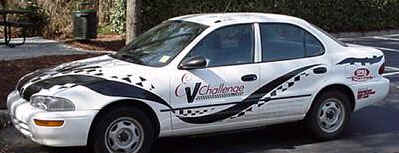Will
internal combustion last forever?
In films which depict the future modes of
transport are very different - take Star Wars for example everyone is zipping
around in flying, jet propelled cars. But what is the real future for transport?
 In a world where global warming is a reality and supply of
fossil fuels is limited it is unlikely that the internal combustion will last
forever. Many countries are introducing legislation that means we have to find
an alternative to gasoline. So where do we go from here?
In a world where global warming is a reality and supply of
fossil fuels is limited it is unlikely that the internal combustion will last
forever. Many countries are introducing legislation that means we have to find
an alternative to gasoline. So where do we go from here?
Electric
Cars: when you think of electric transport milk floats come to mind, but
it's not all 5 miles per hour, things are moving on! In an electric car the engine is replaced by an electric motor and is
powered by a battery through a controller. Usually the battery needs to be
charged overnight. The
main advantages of electric cars are that they are more environmentally friendly, very
quiet and have less moving parts (so are less likely to go wrong).
The main drawback of this type of car is that they have a limited
range, only being able to drive around 50 miles before the battery goes flat.
While it is true that the average distance most of us drive in a day is only 40
miles it seems that electric cars were never destined to leave the city. 
Hybrid
Cars: These combine gasoline and electric power to get the best of both
worlds. Both Honda and Ford have introduced Hybrid cars recently and they have
received a lot of attention. Hybrid cars have a complete electric system and a
low power gasoline engine (which runs at only one speed). The electric power is
used for acceleration and the small engine is used when cruising. When the car slows
back down the electric batteries recharge. This vastly extends the range of the
car and uses gasoline extremely efficiently. These cars can be very heavy but
the manufactures have begun to overcome this problem by using components with
dual functions. For more information go to Honda's
insight. In the short term hybrid cars appear to over the best solution.
Fuel cell vehicles
(FCVs): DaimlerChrysler and Ford both have plans to release fuel cell
powered cars around 2004. These cars carry on board hydrogen (as liquid or gas).
The cars are powered by electrochemically combining the hydrogen with oxygen
from the atmosphere. A proton exchange membrane is used to transport protons to
a positive electrode generating electricity which in turn powers and electric
motor. These cars produce only emit water vapour. For more info follow this link.
Advances have also been made using
methanol as the source of hydrogen. More
on methanol fuel cell vehicles.
For more information on cars
of the future.
(background taken,
without permission, from http://www.siu.edu/~autoclub/frange.html)
(Jetson image from http://www.cybercomm.nl/~ivo/photo.html,
eV car image from http://www.evchallenge.org)
 In a world where global warming is a reality and supply of
fossil fuels is limited it is unlikely that the internal combustion will last
forever. Many countries are introducing legislation that means we have to find
an alternative to gasoline. So where do we go from here?
In a world where global warming is a reality and supply of
fossil fuels is limited it is unlikely that the internal combustion will last
forever. Many countries are introducing legislation that means we have to find
an alternative to gasoline. So where do we go from here?